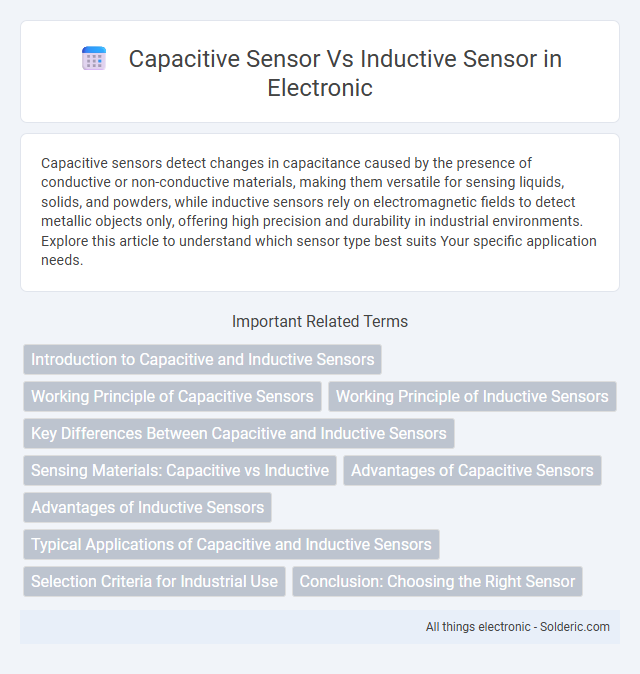Capacitive sensors detect changes in capacitance caused by the presence of conductive or non-conductive materials, making them versatile for sensing liquids, solids, and powders, while inductive sensors rely on electromagnetic fields to detect metallic objects only, offering high precision and durability in industrial environments. Explore this article to understand which sensor type best suits Your specific application needs.
Comparison Table
| Feature | Capacitive Sensor | Inductive Sensor |
|---|---|---|
| Working Principle | Detects changes in capacitance caused by the presence of a target | Detects changes in inductance due to metallic target proximity |
| Target Material | Metallic & Non-metallic (liquids, plastics, wood) | Metallic only |
| Sensing Range | Short to medium (up to several centimeters) | Short (typically up to 8-10 mm) |
| Environmental Sensitivity | Sensitive to humidity, dust, and temperature changes | Less affected by environmental factors |
| Applications | Level detection, material presence, packaging | Metal detection, position sensing, automation |
| Cost | Moderate | Generally lower |
| Response Time | Fast | Very fast |
Introduction to Capacitive and Inductive Sensors
Capacitive sensors detect changes in capacitance caused by the presence of a target, making them ideal for sensing non-metallic materials like plastics and liquids. Inductive sensors rely on electromagnetic fields to detect metallic objects, offering robustness and high sensitivity in harsh industrial environments. Both sensor types serve critical roles in automation, with capacitive sensors excelling in versatility and inductive sensors providing precise metal detection.
Working Principle of Capacitive Sensors
Capacitive sensors detect changes in capacitance caused by the presence or absence of objects, relying on the variation of the electric field between sensor electrodes. Unlike inductive sensors that respond to metallic objects via electromagnetic fields, capacitive sensors can detect both conductive and non-conductive materials such as plastics, liquids, and powders. Your choice of sensor depends on the target object's material and environmental conditions influencing sensor performance.
Working Principle of Inductive Sensors
Inductive sensors operate based on electromagnetic induction, generating an alternating magnetic field from a coil and detecting changes in this field caused by the presence of metallic objects. When a metal target enters the magnetic field, it induces eddy currents that alter the coil's impedance, allowing the sensor to identify the object's proximity without physical contact. This principle makes inductive sensors highly effective for detecting ferrous and non-ferrous metals in industrial automation and machinery monitoring.
Key Differences Between Capacitive and Inductive Sensors
Capacitive sensors detect changes in capacitance caused by the presence of both metallic and non-metallic objects, while inductive sensors detect metallic objects by sensing changes in inductance. Capacitive sensors are suitable for detecting materials such as liquids, plastics, and granular substances, whereas inductive sensors are mainly used for metal detection due to their reliance on electromagnetic fields. Sensitivity to environmental factors varies, with capacitive sensors being more prone to false triggers from humidity or dirt compared to the typically more stable inductive sensors in industrial applications.
Sensing Materials: Capacitive vs Inductive
Capacitive sensors detect changes in dielectric materials by measuring variations in capacitance, making them highly effective for sensing non-metallic objects like liquids, plastics, and glass. Inductive sensors rely on electromagnetic fields generated by coils to detect metallic objects, as metals alter the inductance and frequency of these fields. Your choice between capacitive and inductive sensors depends on the material characteristics of the target object, with capacitive offering versatility and inductive providing precision for metal detection.
Advantages of Capacitive Sensors
Capacitive sensors offer high sensitivity and can detect both metallic and non-metallic objects, including liquids, powders, and granular materials, making them versatile for diverse applications. Their ability to operate without physical contact reduces wear and maintenance, ensuring longer operational life and reliability. You benefit from their precise detection capabilities in environments where traditional inductive sensors might fail due to material limitations or interference.
Advantages of Inductive Sensors
Inductive sensors offer high durability and reliability in harsh industrial environments due to their robust metal detection capabilities and immunity to dirt, oil, and moisture. They provide precise and repeatable sensing of metallic objects without physical contact, minimizing wear and maintenance needs. These sensors excel in fast response times and long operational life, making them ideal for automation and manufacturing applications.
Typical Applications of Capacitive and Inductive Sensors
Capacitive sensors excel in detecting non-metallic objects, liquids, and granular materials, making them ideal for applications like level measurement in tanks, packaging, and food processing industries. Inductive sensors are primarily used for detecting metallic objects, commonly applied in manufacturing automation, metal detection, and position sensing in industrial machinery. Your choice between these sensors depends on the material type and environmental conditions of the application.
Selection Criteria for Industrial Use
Capacitive sensors detect changes in materials' dielectric constants, making them ideal for non-metallic objects, liquids, and powders, while inductive sensors are best suited for metal detection due to their reliance on electromagnetic fields. Your selection criteria for industrial use should consider factors such as target material type, environmental conditions, sensing distance, and required sensitivity. Understanding these differences ensures optimal sensor performance in applications like level detection, presence monitoring, or metal part identification.
Conclusion: Choosing the Right Sensor
Capacitive sensors excel in detecting non-metallic objects and liquids with high precision, while inductive sensors are ideal for reliably sensing metallic targets even in harsh environments. Your choice depends on the application's material requirements and operating conditions, ensuring optimal performance and durability. Selecting the right sensor improves accuracy and longevity in your industrial automation system.
capacitive sensor vs inductive sensor Infographic

 solderic.com
solderic.com